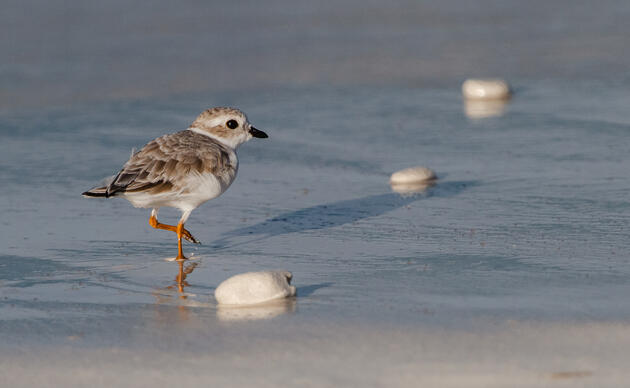Habitat Management at Rowe Sanctuary
Rowe Sanctuary works in cooperation with several conservation organizations to provide cranes optimum roosting sites on the Platte River. In the fall and winter, heavy machinery is utilized to recreate what mother nature can no longer do.
- Managing the Platte River for Cranes
According to some historical accounts, the Platte River was "a mile wide and a inch deep." Wetlands and wet meadows bordered the Platte to capture and hold water that escaped past its banks, and tallgrass prairie bordered the wetlands and wet meadows. Each spring, snow melt from the Rockies would provide scouring flows that removed new vegetation growing on sandbars from the previous growing season.
Today, reduced flows in the river make it necessary for mechanical clearing to maintain wide channels and open sandbars that cranes prefer. A machine called a Klearway is used to remove woody vegetation on established islands by essentially chewing up everything in its path.
Once the island has been cleared, then it is disked in order to inhibit the woody growth even further.
This process must be repeated over time, otherwise the island will disappear in trees.
- Dealing with Invasives
With each passing year, management work within the river channel has become more difficult due to invasive plants. Non-native species such as purple loosestrife and phragmites have spread at an alarming rate in the Platte River Valley, with salt cedar becoming a major concern as well. All three of the plants mentioned remove an incredible amount of water from the river, while at the same time choking out native vegetation. Rowe Sanctuary is working with local, state, and federal agencies to combat this ever growing threat to the Platte River Basin.
- The Importance of Prairie & Wet Meadows
Prairie and wet meadows in the Platte River Valley have decreased over time, but still play an important role during the Sandhill Cranes' stay here in March and early April. The cranes utilize these areas for feeding, loafing, and as secondary roost sites.
- Prairie Management
Native prairie is defined as land that has never been cultivated and consists of grasses and flowering plants (forbs) that were originally found in that region. Rowe Sanctuary has two tracts of native prairie and two areas that have been restored.
The native areas are managed by haying, grazing, and prescribed burns. This is done on a rotational basis, with each practice benefiting the prairie.
The restored areas are enrolled in conservation programs, one in the Conservation Reserve Program, and the other in the Wetland Reserve Program. The purpose of these two programs is to restore marginal cropland back to prairie and wetlands, respectively.
How you can help, right now
Support Rowe Sanctuary
Help us continue our important work for Sandhill Cranes and other birds that rely on the Platte River ecosystem!
Support Spring Creek Prairie
We are able to provide and protect this amazing landscape only with the help of private donations. Help us keep the trails open and the prairie thriving!
Support Audubon in the Great Plains
Support our work with local landowners, urban woods and prairies, and education programs in Nebraska and the Dakotas!




